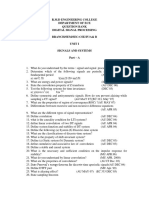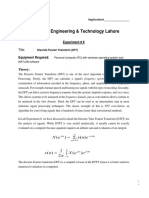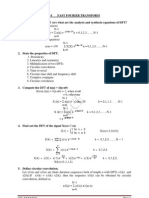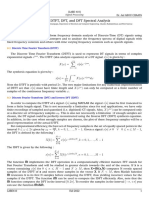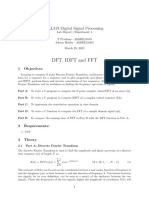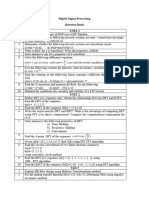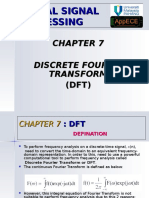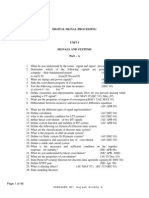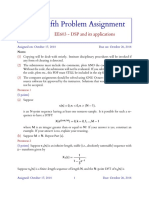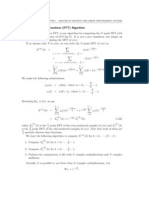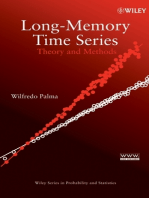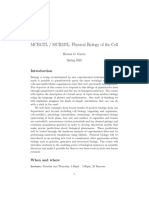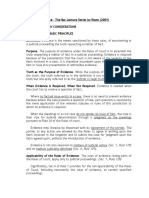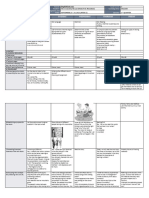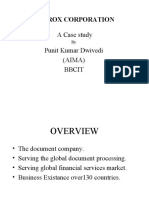Bharathi Education Trust G. Madegowda Institute of Technology (Gmit)
Bharathi Education Trust G. Madegowda Institute of Technology (Gmit)
Uploaded by
harshithaCopyright:
Available Formats
Bharathi Education Trust G. Madegowda Institute of Technology (Gmit)
Bharathi Education Trust G. Madegowda Institute of Technology (Gmit)
Uploaded by
harshithaOriginal Title
Copyright
Available Formats
Share this document
Did you find this document useful?
Is this content inappropriate?
Copyright:
Available Formats
Bharathi Education Trust G. Madegowda Institute of Technology (Gmit)
Bharathi Education Trust G. Madegowda Institute of Technology (Gmit)
Uploaded by
harshithaCopyright:
Available Formats
DIGITAL SIGNAL PROCESSING [10EC52]
BHARATHI EDUCATION TRUST®
G. MADEGOWDA INSTITUTE OF TECHNOLOGY [GMIT]
DEPARTMENT OF ELECTRONICS & COMMUNICATION ENGINEERING
DIGITAL SIGNAL PROCESSING [10EC52]
QUESTION BANK
PART-A
UNIT-1HOURS-06
Discrete Fourier Transforms (DFT): Frequency domain sampling and reconstruction of discrete
time signals. DFT as a linear transformation, its relationship with other transforms.
Frequency domain sampling and reconstruction of discrete time signals
1. Prove that the sampling of DTFT of a sequence x(n) result in N-point DFT. [Jan-15(07M)]
DFT as a linear transformation
2. Define N-point DFT and IDFT of a sequence. [Dec-15(03M)]
3. If w(n)=(1/2)+((1/2)*cos[(2pi/N(n-(N/2)))], what is the DFT of the window sequence y(n)=x(n).w(n)?
keep the answer in terms of X(k). [Jun-14(07M)]
4. Compute the inverse DFT of the sequence X(k)={2. 1+j, 0, 1-j}. [Jun-14(06M)]
5. Define DFT. Derive the relationship of DFT to the z-transform. [Jun-13,jan 15, (05M)]
6. An analog signal is sampled at 10 kHz and the DFT of 512 samples is computed. Determine the
frequency spacing between the spectral samples of DFT. [Jun-13(03M)]
7. Consider a finite length sequence x(n)=δ(n)-2δ(n-5):
i) Determine 10 point DFT of x(n).
ii) Find a sequence, that has DFT where X (k) is 10 point DFT of x(n).
iii) Find a 10 point sequence that has a DFT Y(k) = X(k) W(k), where W(k) is a 10 point DFT of u(n)-
u(n-6). [Jun-11/Jun-13(12M)]
1
{
8. Find the N-point DFT of x(n) if x(n)= 3
;0≤n≤ 2
0 , therwise
[Dec-12(08M)]
9. Find the N-point DFT of x (n) = an for 0 < a < 1. [Jun-12(04M)]
10. Determine 8- point DFT of the signal: x (n) = {1, 1, 1, 1, 1, 1, 0, 0}. Also sketch its magnitude and
phase. [Jun-12/Dec-15/ Dec-12(10M)]
11. Find the l0-point IDFT of [Dec-12(04M)]
12. Find IDFT of X(k) = {4, j2, 0, -j2} using DFT. [Jun-11, Dec-15,jan15,(04M)]
Dept. Of EC, GMIT Page1
DIGITAL SIGNAL PROCESSING [10EC52]
13. Determine N point DFT where n = 0,1,----- N-1.
[Jun-11(06M)]
14. Compute the N point DFT of an and a*n. [Dec-10(12M)]
DFT relationship with other transforms
15. State and prove the relationship between Z-transform and DFT. [Dec-2015,jan-15(06M)]
UNIT-2 HOURS-06
Properties of DFT, multiplication of two DFTs- the circular convolution, additional DFT
properties.
Properties of DFT
1. State and prove the circular convolution property. [Dec-15(06M)]
2. Show that:
(i) Real and even sequence has real DFT.
(ii) Multiplication of two DFT’s in frequency domain corresponds to circular convolution in time
domain. [Dec-12(07M)]
3. State and prove the following properties of DFT. [Dec-11/Dec-10(06M)]
i) Linearity
ii) Frequency shifting.
4. Consider the following 8-point sequences defined for 0<=n<=7.
(i) x1(n)={1,1,1,0,0,0,1,1} (ii) x2(n)={1,1,0,0,0,0,-1,-1}
5. State and prove the following properties:
i) Symmetry property
ii) Parseval’s theorem [jan15 (08M)]
6. Prove: i) Symmetry, ii) Periodicity property of a twiddle factor. [jan 15 (04M)]
Multiplication of two DFTs- the circular convolution
7. For x(n)={7,0,8,0}, find y(n), if Y(K)=X((K-2)4) [Dec-15(06M)]
8. which sequences have a real 8-point DFT? Which sequences have an imaginary valued 8-point DFT?
[Jun-14(05M)]
9. Two 8-point sequences x1(n) and x2(n) are as shown in fig. determine the relation between their DFTs
X1(k) and X2(k). [Jun-14(05M)]
Dept. Of EC, GMIT Page2
DIGITAL SIGNAL PROCESSING [10EC52]
10. Given the wo sequences x(n)=αnand h(n)=βnof length=4, determine y(n)=x(n)©4h(n).[Jun-14(05M)]
11. For DFT pair shown, compute the values of the boxed quantities using appropriate properties.
{x(0),1,2,2,3,3} DFT {12,X(1),-1.5+j0.866,0,X(4),-1.5-j2.598} [Jun-14(05M)]
12. Determine circular convolution of the sequences x,(n) = {1, 2, 3, 1} and x2(n) = {4, 3, 2, 2}, using
DFT and IDFT equations. [Jun-13(08M)]
13. Let X(K) be a 14 point OFT of a length 14 real sequence x(n). The first 8 samples of X(K) are given
by: X(O) = 12, X(1) = -1 + J3. X(2) = 3 + j4. X(3) = 1-.15, X(4) = -2+12, X(5) = 6+.13. X(6) =-2 - J3.
X(7) = 10. Determine the remaining samples of X(K). Also evaluate the following functions without
computing the IDFT [Jun-13(12M)]
14. Determine x3(n)=x1(n)*x2(n) for the sequences, x1(n)=e ; 0 ≤ n ≤7;X2(n)=u(n)-u(n-5). Sketch all
jΠn
the sequences. Use time domain approach. [Dec-12(08M)]
15. Perform circular convolution of the sequences x,(n) = {1, 1 , 2, 2} and x2(n) = {l , 2, 3, 4}, using
tabular arrays. [Jun-12(10M)]
16. Computer the circular convolution between the following sequences using DFT and IDFT methods
x[n] = (1, 2, 3, 4) and y[n] = (-1, -2, -3, -4). X [n] and y[n] are periodic sequences with period N = 4.
[Dec-11/Dec-10(14M)]
17. g(n) and h(n) are the two sequences of length 6 with 6-point DFT's G (k) and H (k) respectively. The
sequence g (n) = {4, 3, 1, 5, 2, 6}. The DFT's are related by circular frequency shift as H (k) =
G ((k-3))6. Determine hen) without computing DFT and IDFT. [Jun-11(05M)]
UNIT-3 HOURS-07
Use of DFT in linear filtering, overlap-save and overlap-add method. Direct computation of DFT,
need for efficient computation of the DFT (FFT algorithms).
Use of DFT in linear filtering
1. What is sectional convolution? Explain any one of them. [Jun-14(08M)]
2. What are FFT algorithms? Prove the i) Symmetry and ii) Periodicity property of the twiddle factor
WN. [Jun-13(06M)]
overlap-save and overlap-add method
3. Explain with necessary diagrams and equations, the concept of overlap-save method for linear
filtering. [Jun-12(10M)]
4. Explain the concept of Overlap - Add method, with the necessary diagram. [Dec-12(08M)]
Dept. Of EC, GMIT Page3
DIGITAL SIGNAL PROCESSING [10EC52]
5. A discrete time LTI system has impulse response
Determine the output of the system if the input is
, using circular convolution. [Jun-12(06M)]
6. A long sequence x(n) is filtered using a filter having impulse response h(n) = {2, 2, 1}.Determine the
output sequence y(n) if x(n) = {3, 0, -2, 0, 2, 1,0, -2; -1, 0}.Use OVERLAP ADD fast convolution
method. [Jun-11(10M)]
7. An FIR digital filter has an unit impulse response h(n) =·{2. 2, 1}. Determine the output sequence y(n)
in response to an input sequence x(n) = {3, 0, -2, 0, 2, 1, 0, -2, -1, 0}. Use OVERLAP SAVE FAST
CONVOLUTION technique. [Dec-12(10M)]
8. A sequence x(n) = {1, 2, -1, 3, 2, -3, -2, -1} is filtered through a filter having impulse response h(n) =
{3, 2}. Find the filter output using OVERLAP ADD method. [Jun-11(08M)]
9. An FIR filter has the unit impulse response h(n)= {1,2}. Determine the output sequence in response to
the input sequence. X(n)={1,-1,2,1,2,-1,1,3} Using over lap-add technique. Use 5-point circular
convolution. [Jun-14(07M)]
10. Consider a FIR filter with impulse response, h(n) {3, 2. 1, 1 }. If the input x(n)= (1, 2, 3, 3, 2,1,-1,-2,
3,5,6,-1,2,1}, using the overlap save method and 8/7 point circular convolution.[Jun-13/Dec-12,jan
15,(10M)]
11. A long sequence x(n) is filtered through a filter with an impulse response h(n) to give an output yen).
If x(n) = (1, 1, 1, 1, 1,3,1,1,4,2,1,1,3, 1) and h(n) = (1, -1),compute y(n) using overlap add or overlap
save method. Use only 5 point circular convolution in your approach. [Dec-10(12M)]
Direct computation of DFT
12. Find the output y(n) of a fiter whose imulse response h(n)={1,2} and x(n)={1,2,--1,2,3,-2,-3,-1,1,1,2,-
1} using overlap save method. [Dec-15(10M)]
13. In the direct computation of N point DFT of x(n), how many
i)complex mutiication ii)compex addition iii)real multiplication
iv)real addition and v) trigonometric fnction evaluations are required. [Dec-15(10M)]
14. Explain in place computation of FFT. [ Ian 15,(2M)]
15. What is in-place computation? What is the total number of complex additions and multiplications
required for N=512 point, if DFT is computed directly and if FFT is used? Also find the number of
stages required and its memory requirements. [Dec-12(06M)]
16. How many complex multiplications and additions are required for computing 256 point DFT using
FFT algorithms? [Jun-13(04M)]
17. Calculate the percentage saving in calculations in a 512-point radix-2 FFT, when compared to direct
DFT. [Jun-14(05M)]
Dept. Of EC, GMIT Page4
DIGITAL SIGNAL PROCESSING [10EC52]
UNIT-4 HOURS-07
Radix-2 FFT algorithm for the computation of DFT and IDFT–decimation-in-time and
decimation-in-frequency algorithms. Goertzel algorithm and chirp-z transform.
Radix-2 FFT algorithm for the computation of DFT and IDFT–decimation-in-time and decimation-
in-frequency algorithms
1. Develop 8-point DFT-FFT radix-2 algorithm and draw the signal flow graph. [Dec-15(10M)]
2. Find 8-point DFT of a sequence x(n)={1,1,1,1,0,0,0,0} using DIT-FFT radix-2 algorithm. Use
butterfly diagram. [Dec-15(10M)]
3. Determine 8-point DFT of a continuous time signal x(t)=sin(2pift) with f=50HZ. Use DIF-FFT
algorithm? [Jun-14(08M)]s
4. What are the difference and similarities between DIF_FFT and DIT-FFT algorithm?[Jun-14(06M)]
5. Find the DFT of the sequence x(n) ={1, 2, 3, 4,4, 3, 2 , 1} using the decimation in frequency FFT
algorithm and draw the signal flow graph. Show the outputs for each stage. [Jun-13(10M)]
6. Develop an 8-point decimation in time FFT algorithm. Draw the complete Signal Flow Graph (SFG).
[Jun-13(08M)]
7. Compute the 4-point FFT of the sequence x(n) = (4. 3. 2, 1) by invoking decimation in frequency
FFT algorithm. [Jun-13(08M)]
8. Tabulate the comparison of complex multiplications and additions for direct computation of DFT
versus the FFT algorithm for N= 32, 128 and 512. [Dec-13(08M)]
9. The first five points of the 8-point DFT X(K) of a real valued sequence are, (0.25, 0.125-j0.3018, 0,
0.125-j0.518, 0). Determine the remaining three points. Estimate the value of x(0). [Dec-13(08M)]
10. Derive DIT-FFT algorithm for N=8 and draw the complete signal graph. [Dec-12,JAN 15(12M)]
11. Find the IDFT of X(k)={0, 2+2j, -j4, 2-2j, 0, 2+2j, j4, 2-2j} using inverse radix-2 DIT-FFT algorithm.
[Dec-12(08M)]
13. Develop the DITFFT algorithm for decomposing the OFT of a 6 valued sequence. Draw thesignal now
graph (SFG). [Jun-12(04M)]
14. If x(n) = {1,2,3,4, 1,2,2, 1}. Compute DFT of x(n) using DIF·FFT algorithm. [Jun-12(10M)]
15.Find the sequence x(n) corresponding to the 8·point DFT, X(K) = {4, 1 - j2.41, 0. 1 - j0.414, 0, 1 +
j0.414, 0,1 +j2.414} by using any of the Radix 2 FFT algorithms to Compute IDFT. [Jun-12(10M)]
16.Find the DFT of x[n] = [1, 2, 3, 4, 4, 3, 2, 1] using the DIT- FFT algorithm. [Dec-10(10M)]
17. Develop an 8 point DIF-FFT algorithm, starting from DFT. State clearly all the steps. Explain how it
reduces the number of computations. [Dec-10(10M)]
18. Explain bit reversal property used in FFT algorithm for N=16 [jan 15 (03M)]
19.Develop DIT-FFT algorithm for N=9. [jan 15 (07M)]
Goertzel algorithm and chirp-z transform
Dept. Of EC, GMIT Page5
DIGITAL SIGNAL PROCESSING [10EC52]
20. What is Geortzel algorithm? Obtain DF_II realization of two pole resonator for computing the DFT?
[Jun-14(08M)]
21. Write a note on chirp Z-transform. [Jun-13(05M)] [Dec-12(06M)]
22. Given x(n) = { 1,0,1,0}, find x(2) using the Goertzel algorithm. [Jun-13(05M)]
UNIT-5 HOURS-06
IIR filter design: Characteristics of commonly used analog filters –Butterworth and Chebysheve
filters, analog to analog frequency transformations.
Butterworth filters:
2 1
1. Given that |H ( JΩ)| = determine the analog filter system function HA(S). [Dec-15(08M)]
1+4 Ω 2
2. Compare Butterworth and Chebyshev filters. [Jun-13(04M)]
3. Derive the expression of order and cutoff frequency of a Butterworth low pass filter.
[Jun-14,Jan 15(08M)]
7Ω 2 1
4. Given that |H ( e )| = determine the analog Butterworth low pass filter transfer function.
1+64 Ω6
[Jun-13(06M)]
Chebysheve filters:
5. Determine the system function Ha(s) that exhibits chebyshev characteristics for the following filter
specifications:
(i) ripple of 0.5 dB in band |Ω|<=1
(ii) At Ω=3 rad/s, amplitude is down by 30 dB. [Jun-14(12M)]
6. Design an analog Chebyshev filter with a maximum pass band attenuation of 2.5 dB at
Ω= 20rad/sec and the stop band attenuation of 30 dB at Ω =50 rad/sec. [Jun-13(10M)]
7. Design a chebyshev analog low pass filter that has -3dB cut off frequency of 100 rad/sec and a
stopband attenuation of 25dB or greater for all radian frequencies past 250 rad/sec. verify the design.
[Dec-12(10M)]
8. Design a low pass Chebyshev filter to satisfy the following specifications:
i) Acceptable pass band ripple of2 dB at a cut off frequency 0 f 40 rad /sec
ii) Stop band ripple of 20 dB or more at 52 rad/ sec. [Jun-12(12M)]
8. Design an analog maximally flat lowpass filter that will have a -I dB cutoff frequency at75Hz and have
greater than 20 dB attenuation in the stop band at a frequency 150 Hz. [Dec-11(10M)]
9. Design a Chebyshev I filter to meet the following specifications: [Dec-11,Jan 15(10M)]
i) Passband ripple: 2 dB ii) Passband edge: 1 rad/sec
iii) Stopband attenuation : 20 dB iv) Stopband edge: 1.3 rad/sec.
Dept. Of EC, GMIT Page6
DIGITAL SIGNAL PROCESSING [10EC52]
10.Design a Butterworth analog high pass filter with the specifications: Pass band gain 0kp = -2dB at pass
band edge frequency Ωp = 200 rad/sec and stop band gain of Ks = - 20dB at stop band edge frequency Ωs
= 100 rad/sec. [Dec-10(10M)]
11. Distinguish between IIR and FIR filters. [jan 15(04M)]
12. Design a chebyshev analog low pass filter that has a -3dB cut off frequency of 100 rad/sec and a stop
band attenuation of25dB or greater for all radian frequencies past 250 rad/sec. [Dec-10(10M)]
Analog to analog frequency transformations
13. Derive the s to z plane transformation based on finite backward difference method. Also show that the
entire left half s-plane poles are mapped inside the smaller circle of radius ½ centered at z=1/2 inside the
unit circle in the z-plane. [Dec-12(10M)]
14.Explain the frequency transformation technique to transform a normalized low pass filter to low pass,
band pass and band reject filters. [Jun-12(08M)]
15.Derive an expression for order of a low pass butter worth filter. [Jan 15(06M)]
UNIT-6 HOURS-07
Implementation of discrete-time systems: Structures for IIR and FIR systems, direct form I and
direct form II systems, cascade, lattice and parallelrealization.
Structures for IIR and FIR systems
1. Realize the FIR filter H(z)=(1/2)+(1/3)Z-1 +Z-2+(1/4)Z-3+Z-4+(1/3)Z-5+(1/2)Z-6 in direct form.
[Dec-15(08M)]
2. Obtain direct form-I,direct form-II, cascade and parallel form realization for the following system
y(n)=0.75y(n-1)-0.125y(n-2)+6x(n)+7x(n-1)+x(n-2). [Dec-15(16M)]
3. What are features of FIR lattice structures? [Jun-14(05M)]
4. What are the conditions to be satisfied while transforming an analog filter to a digital FIR filter?
Explain how this is achieved in Bilinear transformation technique. [Jun-13(05M)]
5. Design a Butterworth filter using the impulse invariance method for the following specifications: Take
T= 1 sec.
0.8 ≤∨H ( e jw )∨≤ 1, 0 ≤ w ≤ 0.2 π ,
{ ¿ H ( e jw )∨≤ 0.2 , 0.6 π ≤ w ≤ π
[Jun-14/Jun-13(10M)]
s+ a
6. Determine H(z) for the given analog system function H ( s )= by using Matched z-transform.
( s +a )2 +b 2
[Jun-13(05M)]
The cascade system should consist of two biquadratic sections.
7. Given H(z)=(1+0.6z-1)5
(i) Realize in direct form
(ii) Realize a cascade of first order section only
(iii) As a cascade of 1st and 2nd order sections. [Dec-12(10M)]
Dept. Of EC, GMIT Page7
DIGITAL SIGNAL PROCESSING [10EC52]
8. Given the system function: [Jun-12(06M)]
Realize using ladder structure.
9. Obtain cascade realization of the system function: [Jun-12(06M)]
10. Obtain the parallel realization for the system function [Dec-11(08M)]
11. Realize the linear-phase FIR filter, with the impulse response [Dec-11(06M)]
12. Realize the linear phase FIR filter having the following impulse response:
[June-11(8M)]
13. Realize the linear phase FIR filter for N to be even. [ jan 15 (08M)]
Direct form I and direct form II systems
14. Obtain DF-I and DF-II structure of the filter is given by
Y(n)=2bcos w0y(n-1)- b2y(n-2)+x(n)-bcosw0x(n-1) [Jun-14(08M)]
15. Obtain the cascade and parallel realization of the system [Jun-14(07M)]
1
1+ Z−1
3
H(z)=
1 3 1
( 5Z 4)
1− −1 (1− z−1 + Z −2)
8
16. Draw the direct form-I and direct form-II realizations for a digital IIR filter described by the system
function [Dec-11(06M)]
17. Obtain the direct form II (canonic) and cascade realization of
[Dec-12(10M)]
Dept. Of EC, GMIT Page8
DIGITAL SIGNAL PROCESSING [10EC52]
18. Consider
[June-11,jan 15 (12M)]
i) Realize the system in direct form 1.
ii) Realize the system in cascade form using the first order and second order form II structures.
iii) Realize the system in parallel form using the first order and second order form II structures.
UNIT-7 HOURS-06
FIR filter design: Introduction to FIR filters, design of FIR filters using -Rectangular, Hamming,
Bartlet and Kaiser windows, FIR filter design using frequency sampling technique.
Design of FIR filters using -Rectangular, Hamming
1. Explain the design of linear phase FIR fiter using frequency sampling technique. [Dec-15(10M)]
2. Compare the rectangular window and hamming window. [Jun-14(04M)]
3. A low pass filter has the desired response as given by
π
jw
H d ( e )=
{
e− j 3 w , 0 ≤ w ≤
0,
π
2
≤w≤ π
2,
Determine the filter coefficients h(n) for M=7 using frequency sampling technique. [Jun-14(08M)]
4. The desired response of low pass filter is
3π 3π
H d ( e jw ) =
{
e− j 3 w ,−
0 ,−
3π
4
4
≤w≤
≤w≤ π
4 ,
Determine H(ejw) for M=7 using Hamming window. [Jun-14,jan15 (08M)]
5. A FIR filter is given by,y(n) = x(n) +(2/5) x(n—1)+(3/4)x(n-2)+(1/3)x(n-3). Draw the direct form I
and lattice structure. [Jun-13,jan 15(10M)]
6. Using rectangular window technique, design a lowpass filter with passband gain of unity, cut off
frequency of 1000 Hz and working at a sample frequency of 5 KHz. The length of impulse response
should be 7. [Dec-12(10M)]
FIR filter design using frequency sampling technique
7. With necessary mathematical analysis, explain the frequency sampling technique of FIR filter design.
[Dec-12(10M)]
8. A low pass FIR filter is to be designed with the following desired frequency transformation methods.
[Dec-12(12M)]
9. Determine the filter co-efficient if the window co-efficient are defined as
Dept. Of EC, GMIT Page9
DIGITAL SIGNAL PROCESSING [10EC52]
Also determine the frequency response of the designed filter.
10. Explain the design procedure of FIR filters, using windows concept. [Dec-12(08M)]
11. Design a symmetric FIR low pass filter whose desired frequency response is given as,
[Jun-12(10M)]
The length of the filter should be 7 and Wc = I rad/sample. Use rectangular window.
12. Design a normalized linear phase FIR filter having the phase delay of T = 4 and at least 40 db
attenuation in the stop band. Also obtain the magnitude/frequency response of the filter.
[Jun-11(10M)]
13. Determine the unit sample response of the ideal low pass filter. [Dec-11(08M)]
UNIT-8 HOURS-07
Design of IIR filters from analog filters (Butterworth and Chebyshev) -impulse invariance
method. Mapping of transfer functions: Approximation of derivative (backward difference and
bilinear transformation) method,Matched z transforms, Verification for stability and linearity
during mapping
Impulse invariance method
1. Explain the design of IIR filter by using Impulse Invariance Method (IIM) technique also explain
mapping of analog to digital filter by IIM. [Dec-15(10M)]
2. Transform the analog filter, into H(z), using the impulse invariant
transformation. Take T = 0.1 sec. [Dec-10/Dec-11(8M)]
3. Convert the analog filter to digital filter H(z) using impulse invariant
transformation. [Jun-11(8M)]
4. Explain how an analog filter is mapped on to a digital filter using impulse invariance method. What
are the limitations of the method? [Jan-15(10M)]
5. Use impulse invariance method to design a digital filter from an analog prototype that has a system
function:
[Jun-11(12M)]
6. Design an IIR digital filter that when used in the prefilter A/D-H(z)-D/A structure will satisfy the
following analog specifications:
(i) LPF with -1dB cutoff at 100𝛑 rad/sec
(ii) Stop band attenuation of 35 dB or greater at 1000𝛑 rad/sec
(iii) Monotonic in SB and PB
(iv) Sampling rate 2000 sample/sec
Dept. Of EC, GMIT Page10
DIGITAL SIGNAL PROCESSING [10EC52]
Use bilinear transformation technique. [Jun-14(14M)]
7. An analog filter has the following system function. Convert this filter into a digital filter using
backward difference for the derivative
1
H ( s )= [Jun-14(06M)]
( s +0.1 )2+ 9
8. Design a linear phase low pass FIR filter with 7 taps and cutoff frequency of Wc = 0.3π rad, using the
frequency sampling method. [Jun-13(10M)]
9. Design an analog Butterworth that has a -2 dB or better cut off frequency of 20 rad/sec and at least 10
dB of attenuation at 30 rad/sec. [Jun-13(08M)]
Backward difference and bilinear transformation
10. Design a unit bandwidth 3 - dB digital Butterworth filter of order one (ONE) by using bilinear
transformation. [Jun-13(08M)]
11. Design a digital filter H(z) that when used in A/D-H(z)-D/A structure, gives an equivalent analog filter
with the following specifications:
PB ripple<= 3.01 dB
PB edge: 500 Hz
SB attenuation >=15dB
SB edge : 750 Hz
Sample rate: 2KHz
The filter is to be designed by performing a bilinear transformation on an analog system function.
Use butterworth prototype. Also obtain the difference equation. [Dec-12(15M)]
1
12. if Ha ( s ) = find the corresponding H(z) using impulse invariance method for sampling
(s +2)(s +1)
frequency of 5 samples/sec. [Dec-12(05M)]
11. What is frequency transformation? Why is it required? [Jun-12(04M)]
12. Compare bilinear transformation with impulse invariance transformation. [Jun-12(06M)]
13. Design first high pass butter worth filter for cutoff frequency = 30 Hz frequency = 150 Hz by bilinear
transformation. [Jun-12(10M)]s
14. Explain the bilinear transform method. Derive an expression showing mapping from s plane to z
plane. Show that there is no aliasing effect in bilinear transformation. [Dec-10(10M)]
15. Show that for β=0, Kaiser window becomes a rectangular window. [jan 15 (05M)]
16. Mention few advantages and disadvantages of windowing technique. [jan 15 (05M)]
Dept. Of EC, GMIT Page11
You might also like
- Sliding D FTDocument4 pagesSliding D FTgaurav_nist100% (1)
- DSP Question Bank With SolutionsDocument46 pagesDSP Question Bank With Solutionsazhagumuruganr73% (22)
- DSP QuestionsDocument46 pagesDSP QuestionsAnonymous tLOxgFkyNo ratings yet
- Gods Black ProphetsDocument3 pagesGods Black ProphetsDavidNo ratings yet
- Risk Assessment and Management in Construction Projects Full Thesis PDFDocument81 pagesRisk Assessment and Management in Construction Projects Full Thesis PDFzakria100100100% (1)
- Bharathi Education Trust G. Madegowda Institute of Technology (Gmit)Document10 pagesBharathi Education Trust G. Madegowda Institute of Technology (Gmit)harshithaNo ratings yet
- Question Bank Unit I Part A: Ae306-Digital Signal Processing AEIDocument4 pagesQuestion Bank Unit I Part A: Ae306-Digital Signal Processing AEIGlanNo ratings yet
- Assignment 1Document2 pagesAssignment 1RaghuNo ratings yet
- Lab 9Document9 pagesLab 9Ahtisham aliNo ratings yet
- DSP 2 Marks Q&a1Document38 pagesDSP 2 Marks Q&a1shankarNo ratings yet
- Digital Signal Processing: Dr. MuayadDocument19 pagesDigital Signal Processing: Dr. MuayadljjbNo ratings yet
- Question Bank For Digital Signal ProcessingDocument8 pagesQuestion Bank For Digital Signal ProcessingRajath VasudevamurthyNo ratings yet
- DSP Ec1302 Parta & Part B Questions and Answers11Document33 pagesDSP Ec1302 Parta & Part B Questions and Answers11ohmshankar100% (2)
- Lab 1: DTFT, DFT, and DFT Spectral Analysis: (LABE 410) Dr. Jad Abou ChaayaDocument4 pagesLab 1: DTFT, DFT, and DFT Spectral Analysis: (LABE 410) Dr. Jad Abou ChaayaJane MoujaessNo ratings yet
- DSP Sample Question - FinalDocument7 pagesDSP Sample Question - FinalMehta SparshNo ratings yet
- Ece Odd9Document17 pagesEce Odd9Venkat MuruganNo ratings yet
- U19ec129 Pcs Labsheet1Document18 pagesU19ec129 Pcs Labsheet1dhanyasri1819No ratings yet
- Lab 6 DFT and FFTDocument16 pagesLab 6 DFT and FFTZia UllahNo ratings yet
- Ece V Digital Signal Processing (10ec52) SolutionDocument101 pagesEce V Digital Signal Processing (10ec52) SolutionVijay Sai100% (1)
- DSP QB Updated - NewDocument7 pagesDSP QB Updated - NewthenithyanagrajNo ratings yet
- QP 2017-1Document2 pagesQP 2017-1nithyaNo ratings yet
- DSP IMP QuestionsDocument5 pagesDSP IMP QuestionsAshok BattulaNo ratings yet
- Lab4 ReportDocument19 pagesLab4 ReportVipulNo ratings yet
- Digital Signal ProcessingDocument40 pagesDigital Signal Processingshankar100% (2)
- Digital Signal Processing - Question BankDocument3 pagesDigital Signal Processing - Question Bankmukeshbalaga2003No ratings yet
- 1 Unit 1: Ques No. UnitsDocument6 pages1 Unit 1: Ques No. Unitsrahulsaraswat_eceNo ratings yet
- BEE4413 Chapter 7Document20 pagesBEE4413 Chapter 7NUrul Aqilah MusNo ratings yet
- DSP Question Bank With SolutionsDocument52 pagesDSP Question Bank With SolutionsRakesh Kumar DNo ratings yet
- Assignment 1Document2 pagesAssignment 1RaghuNo ratings yet
- DSP Two MarksDocument33 pagesDSP Two MarksVijayendiran RhNo ratings yet
- 17EC3601 - DSP - Assignment - I Questions - 2020-21Document1 page17EC3601 - DSP - Assignment - I Questions - 2020-21Mmk ReddyNo ratings yet
- 17EC3601 - DSP - Assignment - I Questions - 2020-21Document1 page17EC3601 - DSP - Assignment - I Questions - 2020-21Mmk ReddyNo ratings yet
- 17EC3601 - DSP - Assignment - I Questions - 2020-21Document1 page17EC3601 - DSP - Assignment - I Questions - 2020-21Mmk ReddyNo ratings yet
- DSP-DFT Properties-OverlapaddsaveassignmentDocument2 pagesDSP-DFT Properties-OverlapaddsaveassignmentChandu ChittiNo ratings yet
- DSP Projects Call 9952749533Document84 pagesDSP Projects Call 9952749533setsindia3735No ratings yet
- MGM's College of Engineering, Nanded: Department of Electronics and TelecommunicationDocument3 pagesMGM's College of Engineering, Nanded: Department of Electronics and TelecommunicationRanjeet Singh 186No ratings yet
- Question BankDocument23 pagesQuestion BankMr Ashutosh SrivastavaNo ratings yet
- EL7133 ExercisesDocument92 pagesEL7133 ExercisesSpiros LoutridisNo ratings yet
- Ec 2302 - DSPDocument49 pagesEc 2302 - DSPShyam SundarNo ratings yet
- 2 MarksDocument5 pages2 MarksSurya arasuNo ratings yet
- DSP Question Paper Unit 1Document10 pagesDSP Question Paper Unit 1shankarNo ratings yet
- One Mark Questions:: EC431 Digital Signal Processing Unit-IIDocument3 pagesOne Mark Questions:: EC431 Digital Signal Processing Unit-IIUday Kiran MuddanaNo ratings yet
- Maulina Putri Lestari - M0220052 - Tugas 2Document6 pagesMaulina Putri Lestari - M0220052 - Tugas 2Maulina Putri LestariNo ratings yet
- DSP Important QuestionsDocument4 pagesDSP Important QuestionsakashcontactspersonalNo ratings yet
- Digital Signal Processing-EC-302T: y (N) Log 10 ( - X (N) - )Document2 pagesDigital Signal Processing-EC-302T: y (N) Log 10 ( - X (N) - )Lakhan BhardwajNo ratings yet
- Lab 8Document8 pagesLab 8shajib19No ratings yet
- Fifth Problem Assignment: EE603 - DSP and Its ApplicationsDocument5 pagesFifth Problem Assignment: EE603 - DSP and Its Applicationschandan choudharyNo ratings yet
- Assignment 1Document3 pagesAssignment 1PUNEET SOMRANo ratings yet
- Section1.4 FFT AlgorithmDocument11 pagesSection1.4 FFT AlgorithmGovardhan Reddy.GNo ratings yet
- FDSP SDocument22 pagesFDSP SYogesh Anand100% (1)
- EXPERIMENT3Document7 pagesEXPERIMENT3Sanjith PranavNo ratings yet
- Green's Function Estimates for Lattice Schrödinger Operators and ApplicationsFrom EverandGreen's Function Estimates for Lattice Schrödinger Operators and ApplicationsNo ratings yet
- Student Solutions Manual to Accompany Economic Dynamics in Discrete Time, second editionFrom EverandStudent Solutions Manual to Accompany Economic Dynamics in Discrete Time, second editionRating: 4.5 out of 5 stars4.5/5 (2)
- On the Tangent Space to the Space of Algebraic Cycles on a Smooth Algebraic VarietyFrom EverandOn the Tangent Space to the Space of Algebraic Cycles on a Smooth Algebraic VarietyNo ratings yet
- Analyzing Neural Time Series Data: Theory and PracticeFrom EverandAnalyzing Neural Time Series Data: Theory and PracticeRating: 4 out of 5 stars4/5 (4)
- Hyrdoacoustic Ocean Exploration: Theories and Experimental ApplicationFrom EverandHyrdoacoustic Ocean Exploration: Theories and Experimental ApplicationNo ratings yet
- Analog Communication (10ec53)Document14 pagesAnalog Communication (10ec53)harshithaNo ratings yet
- Management and Entrepreneurship-10Al51: Dept. of ECE, GMITDocument6 pagesManagement and Entrepreneurship-10Al51: Dept. of ECE, GMITharshithaNo ratings yet
- Fundamentals of CMOS VLSI QBDocument6 pagesFundamentals of CMOS VLSI QBharshithaNo ratings yet
- Source: Diginotes - In: Go Paperless! Save Earth!Document6 pagesSource: Diginotes - In: Go Paperless! Save Earth!harshithaNo ratings yet
- Components Free Electronic Board Defect Detection and Classification Using Image Processing TechniqueDocument7 pagesComponents Free Electronic Board Defect Detection and Classification Using Image Processing TechniqueharshithaNo ratings yet
- Traffic Light Switching by Traffic Density Measurement Using Image Processing TechniqueDocument6 pagesTraffic Light Switching by Traffic Density Measurement Using Image Processing TechniqueharshithaNo ratings yet
- Bare PCB Defect Detection and Sorting Using Image Processing TechniquesDocument5 pagesBare PCB Defect Detection and Sorting Using Image Processing TechniquesharshithaNo ratings yet
- Questions: Practice SetDocument3 pagesQuestions: Practice SetharshithaNo ratings yet
- Questions: Practice SetDocument4 pagesQuestions: Practice SetharshithaNo ratings yet
- 2005 PDFDocument1 page2005 PDFharshithaNo ratings yet
- 03 PICMET Keuper Hellwig SubmissionDocument8 pages03 PICMET Keuper Hellwig SubmissionBekir DayiNo ratings yet
- Essentials of Valid Will (Wasiyat) (Cont.)Document4 pagesEssentials of Valid Will (Wasiyat) (Cont.)kuku_29No ratings yet
- Antiragging FormDocument2 pagesAntiragging FormMohitNo ratings yet
- Leo Strauss - Plato & Aristophanes (1960)Document264 pagesLeo Strauss - Plato & Aristophanes (1960)Giordano BrunoNo ratings yet
- Thermal Conductivity of Refractory Brick PDFDocument7 pagesThermal Conductivity of Refractory Brick PDFFerNo ratings yet
- Adjective Fashion Show Descriptive Writing Unit: Created by Derek Visser ©2016 @mr. Visser's ClassDocument6 pagesAdjective Fashion Show Descriptive Writing Unit: Created by Derek Visser ©2016 @mr. Visser's ClassClaudia Albuccó AriztíaNo ratings yet
- NCCN Rectal Cancer Guidelines-2018-Benson-874-901 PDFDocument28 pagesNCCN Rectal Cancer Guidelines-2018-Benson-874-901 PDFNikos PapaioannouNo ratings yet
- MCB 137L SyllabusDocument6 pagesMCB 137L SyllabusJulianna LammNo ratings yet
- Twin Notice Rule (Labor)Document5 pagesTwin Notice Rule (Labor)Godofredo SabadoNo ratings yet
- Geography Research Project-1Document5 pagesGeography Research Project-1katalachuchuNo ratings yet
- Tagasalo Personality ArraDocument48 pagesTagasalo Personality Arraava12345678900% (1)
- 'Essential GuideDocument5 pages'Essential GuidepriyanktiwariNo ratings yet
- Evidence - The Bar Lecture Series by RianoDocument8 pagesEvidence - The Bar Lecture Series by RianoTristan U. Adviento100% (1)
- Email Schneider To Brian Hagan of First American Bank Re. Request For Modification Update & Provide Status of Litigation W. JPMCDocument242 pagesEmail Schneider To Brian Hagan of First American Bank Re. Request For Modification Update & Provide Status of Litigation W. JPMClschneider68No ratings yet
- Lesson 7. Intro To OODocument41 pagesLesson 7. Intro To OOdavidpotato45No ratings yet
- BS 5896 2010Document33 pagesBS 5896 2010shashiresh50% (2)
- DLL - English 5 - Q1 - W5Document8 pagesDLL - English 5 - Q1 - W5Jessa ValderamaNo ratings yet
- Expecting The Lord's BlessingDocument7 pagesExpecting The Lord's BlessingCharisNo ratings yet
- 120 Degree Mode of ConductionDocument5 pages120 Degree Mode of ConductionAyshwar Venkatesh75% (4)
- Chinese StatueDocument6 pagesChinese StatueUnc lutchedNo ratings yet
- Xerox Corporation: A Case Study Punit Kumar Dwivedi (AIMA) BbcitDocument12 pagesXerox Corporation: A Case Study Punit Kumar Dwivedi (AIMA) Bbcitpurnima30No ratings yet
- Zamboanga V PlagataDocument2 pagesZamboanga V PlagataNikki Estores Gonzales100% (4)
- BACTERIOPHAGEDocument21 pagesBACTERIOPHAGERobin Oben100% (1)
- Dibs in Search of SelfDocument7 pagesDibs in Search of SelfWong Yuet YanNo ratings yet
- Endorsement LetterDocument3 pagesEndorsement LetterJan Emilyn Chavez CatindigNo ratings yet
- Evidence LawDocument6 pagesEvidence LawPsalm KanyemuNo ratings yet
- LSG Unit 1Document12 pagesLSG Unit 1smritig1199No ratings yet
- Certificacion RUPDocument284 pagesCertificacion RUPegarciac77No ratings yet


